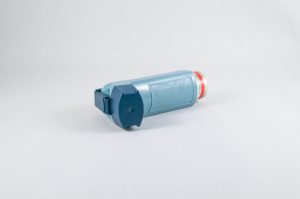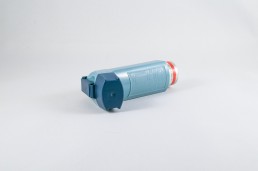Breathe easier with a device that fits on your belt
It has been well researched and proven that higher levels of physical activity translates to a lower mortality rate for those patients with respiratory conditions. The problem to overcome is how to get patients to endure higher levels of exercise when they already have problems breathing as it is. The Non-invasive Open Ventilation (NIOV) device may be able to allow users to increase their physical activity by allowing them to breathe more easily and be portable enough for it to be used during activities.
Previous studies have already shown that dyspnea can be reduced by the device and users' exercise endurance was improved. A more recent study was a lot larger with a more diverse subject pool. Patients used the device for a few hours each day over 6 months. The average number of ER visits lowered, the average stay in ICU lowered and their respiratory testing results also showed a vast improvement. Another study has shown the benefit of patients exercising with both oxygen and NIOV compared to those just exercising or just exercising with oxygen alone. The study concluded that by adding non-invasive ventilation to oxygen during exercise training in patients with severe COPD improved breathlessness, reduced hyperinflation and rates of depression whilst also improving respiratory muscle strength and quality of life.
NIOV is a light, palm-sized device with an easy to use touchscreen that can be strapped to a belt. It increases the amount that you breathe in and delivers a high mixture of oxygen and air. It can be set to three different activity levels; resting, moderate and exercise and can be used plugged in or on the go with a rechargeable battery life of 4 hours. It is connected to a pillows-style nasal interface which is a hybrid between a nasal cannula and a mask but only covers the nostrils allowing you to speak whilst using it. It has been approved by the FDA for patients who suffer from respiratory insufficiency as a result from conditions such as COPD, Interstitial lung disease, neuromuscular conditions and pre/post lung transplant.
The device helps to unload respiratory muscles and allow the lungs to work more efficiently; to make it less of a struggle for users to breathe to allow them to carry out more activities. Patients have the ability to control it when they feel short of breath as and when they need to use it as it is not a continuous device and can be used in conjunction with other supplemental oxygen systems as an additional tool to help slow down the progression of the disease by enabling users to be more physically active.
The next stage of research will be to see the effectiveness of its use during sleeping.
References: http://www.breathetechnologies.com and http://www.hcplive.com and http://www.eurekalert.org and http://copdnewstoday.com
Taking up the flute could improve your COPD symptoms
 For people suffering from respiratory conditions such as COPD, asthma and emphysema, a major daily trial they face is trying to loosen and remove the thick mucus that can build up in their lungs.
For people suffering from respiratory conditions such as COPD, asthma and emphysema, a major daily trial they face is trying to loosen and remove the thick mucus that can build up in their lungs.
The lung flute is a hand-held device that has been designed to help to loosen, mobilize and eliminate airway secretions and mucus build-up. It is simple to use by just blowing into it, just like you would to blow out a candle. It was designed four years ago and approved as a treatment for COPD and now a study by the university of Buffalo has concluded that it is effective at helping patients to breathe more easily.
Its design is based on vibrations. When you blow into the flute it causes an integrated reed to vibrate, which produces a low-frequency sound waves. These acoustic vibrations travel down to the patients' lungs and the waves break up the mucus, which can then be cleared more easily by the patient when they exhale.
When the test subjects used the device twice a day they found that they could breathe a lot more easily and their respiratory tests results were far more improved compared to the test group not using the device. They also experienced less coughing and sputum production. The study also suggested that using the flute results in a decreased likelihood of COPD flare-up and that it may be more effective than similar devices currently used by cystic fibrosis sufferers.
This device; so simple in design, based on simple science, is non-invasive and easy to use could make so many patient's lives so much more bearable, improve their health status and quality of life.
“This study confirms that the Lung Flute improves symptoms and health status in COPD patients, decreasing the impact of the disease on patients and improving their quality of life,” says Sanjay Sethi, MD, principal author of the study. He has led a series of clinical trials demonstrating the safety and efficiency of the Lung Flute, including those that played a key role in the FDA’s approval of the device for diagnostic and therapeutic uses.
The device has also been approved for use by laboratories to obtain deep lung sputum samples for analysis and the flute is currently the focal point of more research into its use for asthma patients and for possible diagnostic use in tuberculosis and lung cancer.
References: http://www.lungflute.com and http://www.buffalo.edu and http://www.gizmag.com
Oxygen could help in the battle against depression
 In March this year researchers showed that rats exposed to high-altitude conditions exhibited increased depression-like behaviour. This study proved that hypoxia (low oxygen levels) is a distinct risk factor for depression in those that either live at high altitudes or suffer from COPD, asthma or who smoke.
In March this year researchers showed that rats exposed to high-altitude conditions exhibited increased depression-like behaviour. This study proved that hypoxia (low oxygen levels) is a distinct risk factor for depression in those that either live at high altitudes or suffer from COPD, asthma or who smoke.
The link between altitude and high depression rates and suicide is very obvious in the intermountain region of the United States where the rates are considerably higher than any other part of America. The region has earned itself the nick-name of the 'suicide belt'.
Rats are not however subject to the same psychological and social pressures as people are and more research on humans would need to be undertaken in order to substantiate this link. Other risk factors are also important such as poverty, low population and psychiatric disorders. This study shows that this risk factor would be present with everybody who either live in high altitudes or suffer with a condition that results in a lowering of oxygen levels in your blood.
Hypoxia is thought to impair an enzyme involved in the synthesis of serotonin (a compound that contributes to happiness and feelings of well-being), resulting in lower Serotonin levels and leading to depression. Depression is normally treated with anti-depressants however 'The Utah Paradox' illustrates how drugs do not necessarily work in high-altitude regions, as Utah has the highest depression index and the highest use of antidepressants in the country.
The fact that both depression and suicide rates increase with altitude, where there are low oxygen levels, implies that antidepressant treatment is not adequate for those suffering from depression and as low oxygen is the main common factor in most cases, maybe this needs to be looked into as a possible new treatment for depression in those that experience low oxygen levels.
Significant improvements were demonstrated when schizophrenic patients underwent oxygen therapy and now they will try it out on sufferers of depression. Oxygen therapy is easy, non-invasive and safe so new research will trial it on sufferers of low and medium-level depression.
Researchers found that exposing psychiatric patients to 40% concentration of oxygen rather than 21% oxygen levels from the air, via a plastic tube is safe and effective and the patients functioned significantly better than those who inhaled normal air. Increasing the supply of oxygen to the brain will increase the function of mitochondria which produce energy in the cells. Poorly functioning mitochondria can disrupt the functioning of neurones and the electrical activity of the brain. Theoretically therefore raising oxygen levels inhaled by patients can improve psychiatric functioning, it now just needs to be proven. If it is proven to be the case then oxygen therapy could relieve depression symptoms in hours/days and weeks compared to antidepressants which can take months and years to take full effect. You wouldn't be using medications but a natural substance, which is easy to use, cheaper and brings about results a lot quicker, reducing the likelihood of a potential attempt on life.
References: http://www.jpost.com and http://www.sciencedaily.com
Asthma treatment could be aided by a sensor and app
 Millions of people suffer the daily struggle of controlling their asthma symptoms. Trying to avoid possible triggers and not knowing when the next attack may occur. Many of the attacks and hospitalizations are preventable if the patient understands their condition and avoids triggers and situations which can cause an asthma attack.
Millions of people suffer the daily struggle of controlling their asthma symptoms. Trying to avoid possible triggers and not knowing when the next attack may occur. Many of the attacks and hospitalizations are preventable if the patient understands their condition and avoids triggers and situations which can cause an asthma attack.
Scientists have developed 'Wing', a pocket-sized device that plugs into your smartphone and can detect early warning signs of an asthma attack, which the company states as being of 'medical-grade' accuracy. By blowing into the sensor it accurately measures lung function by calculating how much air you can exhale in one second and how fast you can exhale and stores and tracks this data.
Everyone's respiratory condition is slightly different but by using the device consistently over time the program can learn about the individual's condition and become personalised. It can allow the patient to visualise their lung function via a 'stop-light' zone system, detect environmental and medication triggers that can cause symptoms to flare-up and help the user be able to take preventative measures to stop an asthma attack from occurring.
Studies carried out with patients using oxygen have shown that where patients are monitoring their lung function better and improving it by avoiding flare-ups and attacks that can cause further damage, the oxygen they are consuming is then being more effectively utilized by their lungs and uptake and subsequent blood oxygen levels are significantly improved.
It can also help monitor other conditions such as cystic fibrosis and other COPD-related conditions. Other user groups such as athletes, singers and wind musicians can also make great use of the app. It can proactively help the user to understand and monitor their lung function and to work with a doctor to avoid triggers and find a treatment plan to keep you breathing at your best. Users have not only been able to avoid attacks but have also improved their lung function, breathing and quality of life.
Wing currently works on any iPhone 5 or later running iOS8 or later with an Android app currently in development and plugs in via the headphone jack port. It runs off of the smartphone battery so no need for an additional power supply.
The device is expected to gain its FDA approval by next year and be ready for purchase by August 2016. This will be an exciting new and easy aid for millions of people to use as part of their treatment plan to help combat various respiratory conditions but is also adaptable to be used by healthy individuals to monitor and improve their lung function.
References: http://lungdiseasenews.com and http://www.gizmag.com and http://www.bizjournals.com
Does gender have an impact on severity of COPD?
Chronic Pulmonary Disease is a leading cause of death around the world. However mortality rates for women are higher than for men, who's mortality rate has actually dropped between 1999 and 2006. The mortality rate for women however did not change and by 2000 women exceeded male mortality rates. This has prompted a shift in the perception that was once held that COPD was a 'male disease' and to look into why women are at a significant risk of death from COPD compared to men.
The primary risk factor for CPD is tobacco smoking. There is new evidence suggesting that the two genders differ in their susceptibility to the effects of smoking.
There may be a gender-specific genetic predisposition for lung damage, also women have smaller airways and therefore smoking the same amount of tobacco as men can result in proportionally more lung damage. Exposure to second-hand smoke, choice of cigarette brands and inhalation methods all may contribute to these gender differences. The number of women smoking also has increased dramatically over the last few decades.
These gender differences may start early in life and may be influenced by sex hormones. A study showed that young girls exposed to pollution and tobacco smoke showed greater lung reduction than the boys.
Smoking women are typically younger when they receive their COPD diagnosis and also the annual progression of COPD is more rapid in female smokers than in male smokers, even if they smoked for fewer years and smoked less than their male counterparts.
However 15% COPD diagnoses are non-smokers and of this group 80% are non-smokers suggesting that it is not just tobacco but other risk factors that contributes to a higher prevalence of COPD in women compared to men. Occupational exposures to dusts, coal and metallic fumes in the agricultural and industrial workplaces are a huge risk factor and over the last few decades more women have entered into these traditionally male occupations. In less-developed countries women are more likely to be employed in the textile, brass-ware, ceramics and glassware industries where there is a risk of exposure to damaging agents.
There is also a difference in the clinical symptoms experienced between the genders. Men report more sputum production and quality of life is lower for women who tend to suffer with higher rates of anxiety and depression and suffer more from shortness of breath. Men demonstrate higher rates of diabetes, sleep apnoea and cardiovascular disease whereas women tend to develop osteoporosis and bowel disease. Women also tend to suffer more with decreased BMI and higher airway obstruction readings and a poorer resulting prognosis. Women are also more likely than men to be diagnosed late, which also impacts upon their health and outlook if treatment is started later after more lung damage has occurred.
Upon diagnosis women tend to be younger than men and examination of their lung tissue shows that women in fact had more airway problems at that point, than men. This may explain why women experience more breathlessness and more of a decreased capacity to exercise than men.
These findings suggest that gender must be considered in future COPD studies and that gender is highly important in the treatment of COPD in the future. Gender-specific treatments may need to be developed as well as trying to diagnose women at an earlier point in their lung deterioration to increase survival rates for women.
References: http://www.webmd.com and http://www.medpagetoday.com
Oxygen could be the key to a cure for diabetes
With Obesity steadily increasing in the Western world, the number of people suffering from Diabetes has become grossly excessive and is on the increase.
 The treatment of Diabetes demands that the diabetic make drastic lifestyle changes. These changes can include: weight loss, rigid exercise programs and a complete restructuring of a person's diet. Unfortunately many patients struggle to initiate and maintain these changes and find themselves being gradually and increasingly affected by damaging symptoms of the disease.
The treatment of Diabetes demands that the diabetic make drastic lifestyle changes. These changes can include: weight loss, rigid exercise programs and a complete restructuring of a person's diet. Unfortunately many patients struggle to initiate and maintain these changes and find themselves being gradually and increasingly affected by damaging symptoms of the disease.
Type 1 diabetes is caused by the immune system attacking itself and destroying cells in the pancreas. The pancreas produces insulin and so it results in the body not producing enough. It can be caused by an infection, toxins or an autoimmune reaction. Type 2 diabetes can be caused by multiple risk factors including obesity, increasing age, poor diet, pregnancy and illness.
When there isn't enough insulin or the insulin is not used as it should be, glucose (sugar) can't get into the body's cells and builds up in the bloodstream. Since the cells aren't getting the glucose they need, they can't function properly and the build up causes damage in multiple areas of the body, leading to many various diabetes-related diseases and conditions.
A new bio-material has been designed which has the capacity to spontaneously generate oxygen when it is exposed to water. This material allows oxygen to be released in the bloodstream in targeted or generalised areas increasing oxygen levels within the body and not relying on lung function. A major potential use of this material is that it can be used in transplantation and skin grafts. Normally when new cells are surgically placed it takes a while for the body to form a blood supply network to these new cells and many die off in the early stages. This material would allow an immediate oxygen supply and increase the chances of the organ or cells taking hold. In particular it would be beneficial for transplanting pancreatic cells as these require huge amounts of oxygen to survive and function. Successful pancreatic cell transplants would give patients with Type 1 diabetes the ability to produce their own insulin.
This however is still in its early days and much more research is needed before it can hopefully start treating those with diabetes. More and more patients are seeking out alternative and natural remedies to help treat their symptoms but it seems that oxygen therapy is often overlooked. Oxygenating the cells in your body is proven to have many positive health benefits and it has been found that it can aid in the prevention of several diabetic symptoms.
A main complication of diabetes is limb amputation due to a lack of circulation. Regular oxygen therapy has been shown to aid cellular oxygenation and healing, increasing the oxygen levels reaching your extremities to prevent cell death and helping to heal ulcers.
Diabetic patients are 3 times more likely to develop Glaucoma which can lead to blindness. Supplemental oxygen has been shown to ensure continued oxygenation to the eye and to relief the pressure that the fluid build-up can cause. Glaucoma is also difficult to spot until it is too late therefore taking supplemental oxygen can help to ward off this symptom before it's too late.
Diabetes also weakens the body and its ability to self-heal and can affect the sensory areas of the brain. Many Type 1 sufferers experience symptoms similar to being under the influence of alcohol which can have a major impact of their day-to-day life. Supplemental oxygen has been shown to aid in nerve regeneration and general body repair and healing which can alleviate these symptoms.
Oxygen Therapy is an effective alternative treatment for diabetes and can be used as a method of prevention against certain debilitating ailments commonly experienced by diabetics. Talk to your GP about the possibility of being prescribed oxygen via the NHS or there are many private companies that can supply oxygen concentrators to you.
References: www.miami.edu and www.mroxygen.co.za and www.diabetes.co.uk
Good bacteria could be the key to curing asthma
 Asthma is caused by your airways being more sensitive to irritants and becoming inflamed, making it difficult to breathe. Cases are on the increase and one in every 11 children in the UK are now diagnosed with Asthma. One explanation for the rise in Asthma is the 'Hygiene Hypothesis', which has been discussed for many years. This suggests that children are no longer exposed to enough bacteria at an early age, which normally would help to build the immune system to be able to tell the difference between friend and foe bacteria. This results in the immune system believing that pollen and other triggers are harmful resulting in the airways becoming inflamed as the immune system attacks.
Asthma is caused by your airways being more sensitive to irritants and becoming inflamed, making it difficult to breathe. Cases are on the increase and one in every 11 children in the UK are now diagnosed with Asthma. One explanation for the rise in Asthma is the 'Hygiene Hypothesis', which has been discussed for many years. This suggests that children are no longer exposed to enough bacteria at an early age, which normally would help to build the immune system to be able to tell the difference between friend and foe bacteria. This results in the immune system believing that pollen and other triggers are harmful resulting in the airways becoming inflamed as the immune system attacks.
On the back of these discussions a team analysed the billions of bugs that naturally occur within the human body. Microbes, bacteria and fungi outnumber human cells 10 to one and this 'microbiome' is thought to be key to our health. They found that if there were four main groups of bugs missing then the risk of developing asthma was very high. The types of bacteria are faecalibacterium, Lachnospira, Veillonella and Rothia. The team looked for the presence of these bacteria in children aged 3 months and one year and then looked to see if they developed asthma by the age of 3. The lack of these bacteria in both age groups resulted in a high risk of developing asthma by the age of 3.
It appears that the first year of life is crucial and that the 'right bugs at the right time' could be the best way of preventing asthma and other allergies. Exposing children in the first year of life to a wide variety of bacteria could help to ensure that their immune system is calibrated correctly and prevent later development of asthma.
Further experiments, which looked into the 'passing down of immunity' from mother to child involved giving a bacterial cocktail to mice who then had offspring with reduced inflammation in their lungs. Other suggestions involve the fact that giving birth by Caesarean section and not breast feeding may both limit the bacteria from being passed from mother to child and hinder immune system development.
Dr Marsland from Switzerland has been researching this area for a number of years and believes that diet, microbes and the first year of life are key in preventing or easing Asthma symptoms. He believes that a high fibre diet is important for keeping the gut healthy, as it is the delicate balance of gut bacteria in our bodies that affects our immune system and may play a role in asthma development.
However this is just a step in the right direction, more research needs to be carried out into these four types of bacteria, their role within the body and their relationship with the immune system and conditions like allergies and Asthma. If there is a direct link then new information could be given to new parents about exposing children to bacteria, a bacteria cocktail could potentially be created to be given to pregnant women or young children, there may also be a way of training the immune system at a later stage of development by introducing these bacteria to patients to try and cure or lessen their Asthma.
Scientists urge people not to run out and buy lots of friendly bacteria yogurt drinks and pro-biotic yogurts, as much more research is needed to ascertain the facts and details of what this discovery actually means for the larger population in real life. Doctors urge Asthma patients to continue with their inhalers, medications and oxygen therapy as prescribed, which all help to ease the symptoms.
References: http://www.nhs.uk and http://www.bbc.co.uk
'TIS THE SEASON FOR COPD EXACCERBATIONS
 Research shows that COPD sufferers are more likely to be hospitalised during the Christmas holiday period than at any other time during the winter. This is in part due to developing respiratory infections on the weeks leading up to Christmas as the weather gets colder but also these are more easily spread at holiday social events, which are more frequent on the lead up to Christmas. With more germs around, colder weather acting as a trigger, increased social occasions and the extra stress of shopping and travelling leading up to Christmas, all increases the risk of infections, frequency of flare-ups and potential hospitalisation. Also remember that over Christmas you may not have as much access to medical assistance so preparation and check-ups before GP surgeries close and other services become minimised is very important.
Research shows that COPD sufferers are more likely to be hospitalised during the Christmas holiday period than at any other time during the winter. This is in part due to developing respiratory infections on the weeks leading up to Christmas as the weather gets colder but also these are more easily spread at holiday social events, which are more frequent on the lead up to Christmas. With more germs around, colder weather acting as a trigger, increased social occasions and the extra stress of shopping and travelling leading up to Christmas, all increases the risk of infections, frequency of flare-ups and potential hospitalisation. Also remember that over Christmas you may not have as much access to medical assistance so preparation and check-ups before GP surgeries close and other services become minimised is very important.
It is very important to take care of yourself as the weather turns colder to ensure you stay healthy throughout the winter season.
To protect your breathing this holiday season:
- Wash your hands properly and often
- Stay away from people who are sick.
- Make sure your prescriptions are up-to-date so that you are prepared to treat a flare-up.
- Keep your medicine on hand.
- Watch your symptoms and get medical help if you need it.
- If you’re travelling, take extra supplies of your medicine.
- Ensure you have enough oxygen supply and an emergency back-up just in case your oxygen requirements increase suddenly or there is a power outage
To prevent flare-ups, avoid these indoor triggers:
- Decorations: When you get your holiday decorations out of storage remember they are most likely covered in dust. If the area where you store them has dust and mildew, proactively use your inhaler if prescribed one, and wear a mask, scarf or bandana for protection from these particles. Then wipe down all your decorations with a cloth to remove any dust before you deck the halls.
- Trees: Freshly cut Christmas trees are beautiful but they can also contain pollen and mould spores, which can trigger breathing problems. If you bring home a live tree for the holiday season, rinse it with a hose and let it dry in your garage before bringing it into the house.
- Hosting: People tend to deep clean their homes before being inundated with guests over Christmas. However excessive use of cleaning products can trigger flare-ups but there are lots of home remedies that work just as well that don't contain chemical triggers.
- Scents: Holiday scents can be a great addition to the festivities but things like candles, incense and air fresheners can also be a trigger. While they smell good, they may not be good for you or your guests with respiratory challenges.
- Be careful of your diet, the holiday season throws up a host of rich and sugary foods but ensure you maintain a well-balanced diet as poor eating and diet can trigger a flare-up or make you more susceptible to a respiratory infection.
- Be aware of wood smoke from stoves and fireplaces
Cold dry winter air can be a trigger for some people with asthma and COPD:
- Wear a scarf or face mask over your nose and mouth, to help warm the air before you breathe it in.
- Breathe through your nose, not your mouth – this also helps warm the air before it reaches your lungs.
- If you plan to exercise outdoors, first do warm-up exercises indoors.
- If need be, take a dose of your inhaler or oxygen before you go outside.
If you are prepared and take precautionary measures and monitor your symptoms then you should make it through the holiday season in good health.
Some COPD patients find it easier and safer to not be at home for the depths of winter to avoid ill health and chose to travel abroad to warmer climates, either with their partner or to visit friends and family. This way you can avoid the cold weather and its complications all together. Many find that being on holiday is more relaxing and the warmer weather helps to improve their health. Travelling abroad with oxygen is easy to arrange with a global company that can arrange and supply all your oxygen requirements from the second you step off the plane. Just check with your doctor that you are allowed to fly, look up helpful information on flying with COPD and contact a company, such as Oxygenworldwide who will ensure that your holiday runs smoothly. You do not want to be travelling abroad to ensure the cold doesn't affect your health to then be faced with other problems abroad so just ensure you use a reputable company and make suitable preparations.
References: http://sct.poumon.ca and http://www.ncbi.nlm.nih.gov and http://propellerhealth.com
COPD morning blues
 COPD symptoms are experienced throughout the day, however the morning is often the most difficult time for patients. The condition negatively impacts upon their normal daily activities from the minute they wake up in the morning. They find that their morning routine of getting up, showering and getting ready are significantly slowed down due to COPD symptoms. Patients often find that the interference from the symptoms in the morning is a greater challenge than the symptoms themselves.
COPD symptoms are experienced throughout the day, however the morning is often the most difficult time for patients. The condition negatively impacts upon their normal daily activities from the minute they wake up in the morning. They find that their morning routine of getting up, showering and getting ready are significantly slowed down due to COPD symptoms. Patients often find that the interference from the symptoms in the morning is a greater challenge than the symptoms themselves.
Symptoms such as breathlessness, wheezing, coughing and phlegm production are all increased usually due to a build-up of mucus overnight and for many it means that more strenuous activities tend to take longer and many find that they have to get up earlier to allow time to complete them. Many patients report that they have had to change their morning routine to compensate, either changing the order in which they do things, allowing more time and rest gaps or changing activities completely.
Some rest in bed for a short period upon waking before even getting out of bed, some also take medication or oxygen at that point also. Many avoid the stairs and some switch from showers to baths as it is less strenuous and you can rest your legs. Also having a breakfast that is quicker to prepare such as fruit and yoghurt helps save time and effort. Grab bars in the shower or along long hallways allow you to have a rest if needed.
Morning headaches are another common complaint from COPD patients, usually those who need night-time therapy or are in more developed stages of the disease. These dull, throbbing headaches are present as soon as they wake up. The cause is either too little oxygen in the blood or too much carbon dioxide in the blood which is a result of the lung damage. Another cause can be too much oxygen in the blood, a result of night-time oxygen therapy. This imbalance of carbon dioxide or oxygen can cause blood vessels to expand as the brain tries to get as much oxygen as possible and causes the headaches. If the headaches are due to night-time therapy then your flow rate can be adjusted to try and stop this from happening. If the headaches are due to general COPD night-time breathing then exercise can help to improve lung function and medications can help to reduce the swelling of the arteries. Some find that a short burst of oxygen in the morning can alleviate them and the right pillow can help to keep the head in the best position for breathing.
Morning symptoms can interfere with a patient's career, lifestyle and mental well-being. Based on a recent survey, 1 in 4 working patients had to change jobs, 1 in 2 are often late for work or appointments and 2 in 3 had to cut back working hours. So even though your symptoms may only be bad in the morning and alleviate throughout the day, the impact they can have upon your morning routine can alter many major aspects of your life. Therefore it is important to keep in communication with your doctor and to try any of the tips above to try and reduce these symptoms to help improve the patient's quality of life.
References: www.novartis.com and www.epgonline.org and
Could oxygen therapy help to alleviate symptoms for M.E patients?
ME or Myalgic Encephalopathy is one of a few different names that are given to what is an illness of uncertain cause that affects thousands of people. It is also known as Chronic Fatigue Syndrome (CFS), Post-viral Fatigue Syndrome (PVFS) and Chronic Fatigue Immune Dysfunction Syndrome (CFIDS). All types of people of all ages are affected and for many years much controversy surrounded ME as the whether it was in fact an illness at all. Patients suffer from severe and debilitating fatigue, painful muscles and joints, disturbed sleep, gastric disturbances, poor memory and concentration and the onset is usually linked to a viral infection, operation or an accident, although some suffer a slow steady onset.
In some patients the effects are minimal but for others lives are changed drastically. In the young school-life can be severely disrupted and for older patients employment can become impossible. Social/family life can become restricted and many are housebound or even bed-bound for months or years.
Any vigorous exercise such as running or biking can result in the patient being bed-bound and most patients focus on more mild exercising like walking, swimming, tai chi etc.
A study discovered that patients were getting the blood they needed to the muscles but for some reason they weren’t taking up the oxygen very quickly and it took longer for the oxygen levels to get back to normal after exercise.
It could be that the mitochondria in the cells which use oxygen to produce energy could be damaged. These mitochondria also would normally pump damaging free-radicals out of the cell which could interfere with muscle metabolism and cause pain.
Oxygen uptake into the cells would also normally neutralise lactate build-up created during exercise and in the patients in the study it took longer for the oxygen to neutralise the toxic build-up in the cells after exercise.
Another study found that in ME patients specifically that there was significantly lower blood volumes which could account for lower oxygen levels, on average a 20% reduction, which could be cause by the nervous system. In fact some doctors believe that ME may be caused by low oxygen levels. An additional theory is that the nervous system shuts down blood vessels when an ME patient is at rest and then fails to open them up sufficiently when you become active, which is a bad combination when the patient cannot sleep at night and then cannot fulfil any activities during the day.
If low oxygen levels are a root cause of ME then it is being researched at the moment as to whether increasing oxygen levels ie via home oxygen therapy would help to alleviate the symptoms of this disease. Many patients with other conditions such as COPD and Sleep Apnoea have discovered that by using oxygen for these other conditions it has also alleviated their ME symptoms as well. Some find that a 15minute session twice a day can help to nip the symptoms in the bud, others did not or found that longer or more frequent sessions were needed. Others find it helpful to have oxygen on board the air plane when travelling on holiday as before they had experienced increased symptoms whilst away on previous holidays. Patient's with Sleep Apnoea have found that oxygen not only helped with their sleep but made them feel more energised and decreased the severity of their fatigue in the mornings and made the syndrome much easier to live with. It seems to vary from patient to patient as to if and how it helps, as for example some COPD patients find that their oxygen tanks and concentrators helped, whereas others found that only by switching machines to a CPAP machine did it help with their ME symptoms.
It seems from the evidence and patient feedback that there is a link and that increasing oxygen intake to increase blood oxygen levels does, in most cases help to alleviate or extinguish ME symptoms. However with the syndrome itself still unexplained and only a few studies having been carried out so far on this topic, much more research is needed to conclusively prove the link. Also as patients sometimes have a mixture of different inter-linking conditions and causes of their ME symptoms, different patients may respond differently so it may be a case of trial and error as to how you can increase your oxygen levels in a way that will work to alleviate your ME symptoms.
Reference: www.meassociation.org.uk and www.cortjohnson.org and www.actionforme.org.uk














